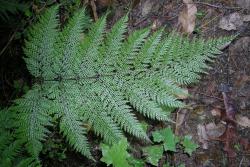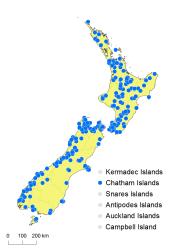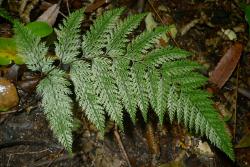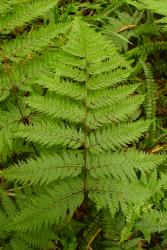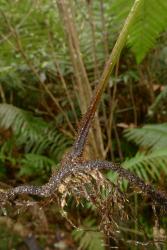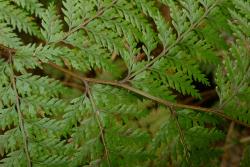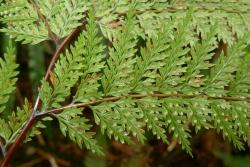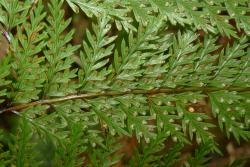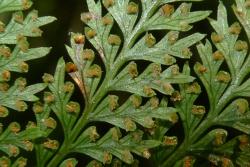- ≡ Davallia novae-zelandiae Colenso, Tasmanian J. Nat. Sci. 2: 182 (1845)
- ≡ Acrophorus hispidus T.Moore, Proc. Linn. Soc. London 2: 286 (1854) nom. illeg., nom. nov. pro Davallia novae-zelandiae Colenso 1845
- ≡ Microlepia novae-zelandiae (Colenso) J.Sm., Cult. Ferns 67 (1856)
- ≡ Dennstaedtia novae-zelandiae (Colenso) Keyserl., Polyp. Herb. Bunge. 22 (1873)
Rhizomes long-creeping, 1–3 mm diameter, with stipes arising 20–175 mm apart; bearing chestnut-brown multicellular hairs up to 2 mm long. Fronds 135–1150 mm long. Stipes 40–675 mm long, 0.5–4 mm diameter, red-brown or becoming chestnut-brown distally, bearing chestnut-brown multicellular non-glandular hairs up to 3 mm long proximally. Rachises chestnut-brown or becoming yellow-brown distally, smooth and polished, bearing hairs at pinna junctions on adaxial surface up to 2 mm long, scattered hairs elsewhere, or rarely abundantly hairy in developing fronds. Laminae 3-pinnate-pinnatifid to 4-pinnate-pinnatifid, ovate or elliptic or broadly ovate, tapering to a pinnatisect apex, 65–530 mm long, 40–500 mm wide, dark green to yellow-green on both surfaces, coriaceous, glabrous or with very scattered colourless or pale brown multicellular non-glandular hairs. Primary pinnae in 15–27 pairs below pinnatisect apex, overlapping or sometimes the proximal ones not overlapping, narrowly winged distally; distal primary pinnae narrowly ovate; proximal primary pinnae ovate; the longest at or near the base, 22–260 mm long, 11–125 mm wide, apices acute or acuminate, bases short-stalked. Secondary pinnae narrowly winged, decreasing gradually in length along acroscopic side of primary pinnae to the distal end; the basal basiscopic secondary pinna inserted at a more acute angle than the basal acroscopic one and sometimes shorter; the longest secondary pinnae narrowly ovate, 8–80 mm long, 4–32 mm wide, apices acute or acuminate, bases stalked. Tertiary pinnae narrowly ovate, 3–23 mm long, 1–8 mm wide, apices acute, bases stalked, usually deeply divided more than halfway to the midrib into ultimate segments, or rarely undivided in the smallest specimens and completely divided into quaternary pinnae in the largest. Sori round or oblong. Indusia ovate or broadly ovate or triangular, margins toothed.
Leptolepia novae-zelandiae can be recognised by its creeping rhizomes, red-brown or chestnut-brown stipes and rachises, highly divided laminae bearing non-glandular multicellular hairs, and round submarginal sori that are protected by ovate or triangular indusia opening towards the lamina margin. The basal basiscopic secondary pinnae on each primary pinna are often greatly reduced.
North Island: Northland, Auckland, Volcanic Plateau, Gisborne, Taranaki, Southern North Island.
South Island: Western Nelson, Sounds-Nelson, Marlborough, Westland, Canterbury, Otago, Southland, Fiordland.
Chatham Islands, Stewart Island.
Altitudinal range: 30–900 m.
Leptolepia novae-zelandiae is widely distributed in lowland and montane areas of the North Island from Te Paki to Wellington, mostly above 100 m and reaching over 900 m on Mt Hauhungatahi and Mt Taranaki. In the South Island it occurs in lowland and montane areas throughout, although it is scarcer on the east coast and largely absent from the drier parts of Marlborough, South Canterbury, Otago and northern Southland. It ranges from c. 30 m up to 750 m in Blue Duck Reserve, near Kaikōura. It also extends to Stewart Island and the Chatham Islands.
Leptolepia novae-zelandiae grows in shaded podocarp, broadleaved and beech forest. It favours damp soils in gullies and on stream banks, river terraces, banks, and tracksides, and occasionally on rotting logs.
n = c. 47 (Brownlie 1961).



